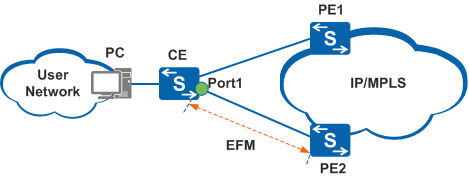Configuring Remote Fault Indication
Context
Remote fault indication is used to detect remote device faults and monitor Ethernet performance. After EFM connections have been established, EFM entities exchange Information OAMPDUs. When traffic is interrupted because an EFM entity fails or becomes unavailable, the faulty EFM entity sends an Information OAMPDU that carries a critical link event flag to its remote EFM entity, record a log, and send an alarm. The remote fault indication helps administrators to learn the link status in real time and troubleshoot link faults promptly.
In Figure 1, if a fault occurs on PE2, PE2 sends an Information OAMPDU that carries a critical link event flag to the CE. Association between EFM and Port1 is triggered and services are switched to the backup path. This association ensures reliable traffic transmission.
EFM can be configured on Layer 2 and Layer 3 Ethernet interfaces. By default, an Ethernet interface works in Layer 2 mode. Before configuring EFM on a Layer 3 Ethernet interface, switch the Ethernet interface to Layer 3 mode.
Pre-configuration Tasks
Before configuring remote fault indication, perform the task of Configuring Basic EFM Functions.
Procedure
- Run system-view
The system view is displayed.
- Run interface interface-type interface-number
The view of the interface at one end of the link is displayed.
- (Optional) On an Ethernet interface, run undo portswitch
The interface is switched to Layer 3 mode.
By default, an Ethernet interface works in Layer 2 mode.

Only the S5720-EI, S5720-HI, S5730-HI, S5731-H, S5731-S, S5731S-H, S5731S-S, S5732-H, S6720-EI, S6720-HI, S6720S-EI, S6730-H, S6730S-H, S6730-S, and S6730S-S support switching between Layer 2 and Layer 3 modes.
- Run efm { critical-event | dying-gasp | link-fault | timeout } trigger error-down
Association between EFM and the interface is configured. The association will be triggered if a remote fault occurs.
By default, association between EFM and the interface is not triggered by a remote fault.
The efm trigger error-down command associates an error event with an interface. When EFM detects critical-event, dying-gasp, link-fault, or timeout faults, the protocol status of the interface becomes Down and all services are interrupted on the interface. Traffic will not be switched back even if the faulty link recovers and the protocol status of the interface does not change. You need to manually check link quality before switching traffic back to the original link.
